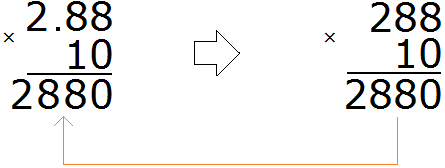Multiplying decimals by 10, 100 or 1000 is done in the same way as multiplying decimals by regular numbers.
You must do the multiplication without paying attention to the dot in the decimal, then separate the whole part from the fractional part in the answer by counting off as many digits to the right as there were digits after the dot in the decimal.
For example, multiply 2.88 by 10
Multiply the decimal 2.88 by 10, ignoring the dot in the decimal:

We got 2880. In this number you need to separate the whole part from the fractional part with a dot. To do this, count the number of digits after the dot in the fraction 2.88. We see that there are two digits after the dot in the fraction 2.88.
Go back to the number 2880 and start moving from right to left. We need to count the two digits to the right and put a dot:

The answer is 28.80. We discard the last zero and get 28.8. So the value of the expression 2.88×10 is 28.8
2.88 × 10 = 28.8
There is a second way to multiply decimals by 10, 100, 1000. This method is much easier and more convenient. It consists in moving the point in the decimal to the right by as many digits as there are zeros in the multiplier.
For example, solve the previous example 2.88×10 this way. Without giving any calculations, we immediately look at the multiplier 10. We are interested in how many zeros it contains. We see that it has one zero. Now in the fraction 2.88 move the point to the right by one digit, we get 28.8.
2.88 × 10 = 28.8
Let's try multiplying 2.88 by 100. Immediately we look at the multiplier 100. We are interested in how many zeros it contains. We see that it has two zeros. Now in the fraction 2.88 move the point to the right by two digits and we get 288
2.88 × 100 = 288
Let's try multiplying 2.88 by 1000. Immediately we look at the multiplier of 1000. We are interested in how many zeros it contains. We see that it has three zeros. Now in the fraction 2.88 we move the point to the right by three digits. The third digit is not there, so we add another zero. We end up with 2880.
2.88 × 1000 = 2880
2. If you find an error or inaccuracy, please describe it.
3. Positive feedback is welcome.